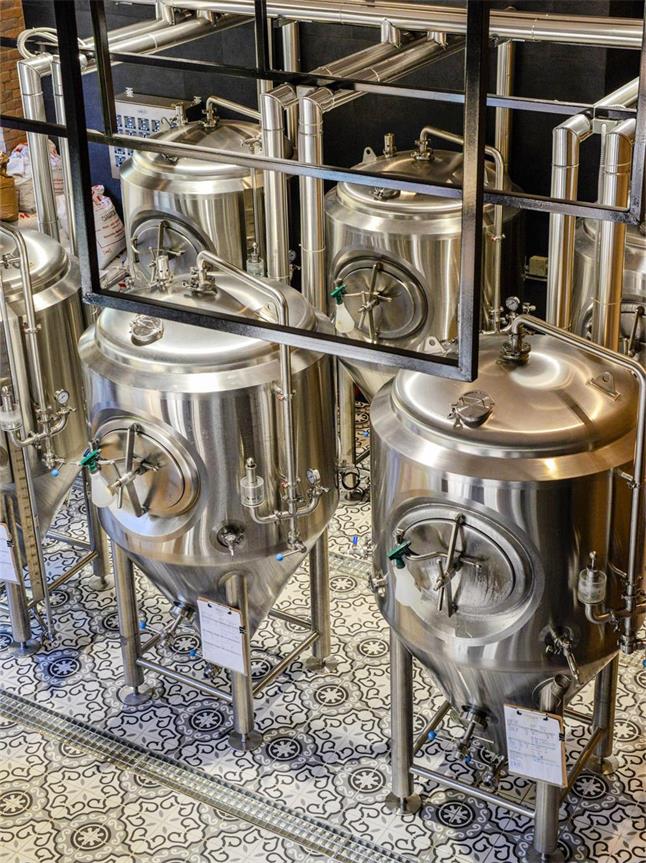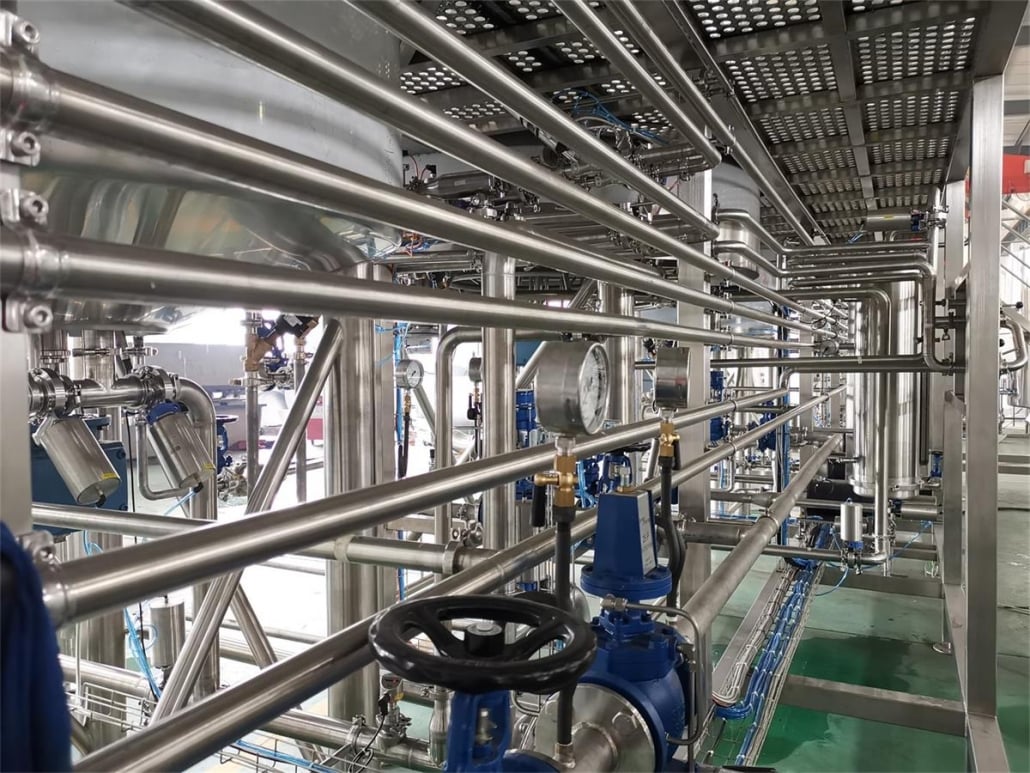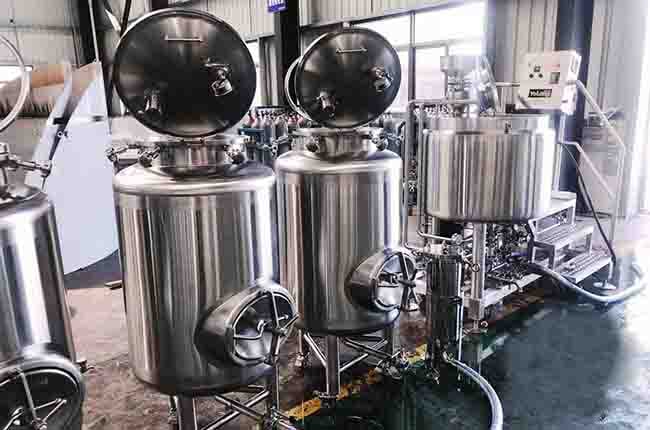Industrial Beer Brewing Equipment
Industrial beer brewing equipment refers to the large-scale systems and machinery used to produce beer in commercial breweries. This equipment allows breweries to increase production volume and automate processes.
Brewing Equipment Guide
The main types of industrial brewing equipment include:
| Equipment Type | Description |
|---|---|
| Mash Filters | Extract sugars from mashed grains |
| Brew Kettles | Boil mash with hops and other ingredients |
| Fermentation Tanks | Allow fermentation of sugary liquid into alcohol |
| Bright Beer Tanks | Filter, carbonate and store finished beer |
| Keg Fillers | Fill kegs with finished beer |
| Control Systems | Automate monitoring and control of process |

Industrial Beer Brewing Process
The typical industrial beer production process using this equipment is:
- Milling – The malted barley is ground into grist using a mill.
- Mashing – The grist is mixed with hot water in a mash filter to extract fermentable sugars.
- Lautering – The sweet liquid wort is separated from the grains.
- Boiling – The wort is boiled with hops in the brew kettle.
- Cooling – The hopped wort is rapidly cooled.
- Fermenting – Yeast is added to fermentation tanks allow conversion of sugars into alcohol.
- Conditioning – The green beer is carbonated and cleared of particles.
- Packaging – Finished beer is put into kegs, bottles or cans.
Equipment Capacity, Design and Customization
Industrial breweries use customized equipment sized for their desired capacity:
| Parameter | Typical Range |
|---|---|
| Annual beer production capacity | 1,000 – 10+ million barrels |
| Mash filter capacity | 500 – 10,000 kg/batch |
| Brew kettle size | 500 to 5,000 barrel batches |
| Fermentation tank size | 100 to 3,000 barrels each |
| Bright beer tank size | 500 to 5,000 barrels each |
The equipment layout and workflow design is customized for each brewery. Factors like number of beer types, package types, future expansion, production flow and building constraints are considered.
Suppliers and Price Considerations
There are a number of industrial brewing equipment manufacturers worldwide. Pricing varies based on specifications:
| Supplier | Price Range |
|---|---|
| JVNW | $100K – $5 million |
| Premier Stainless Systems | $50K – $1 million |
| Rolec Prozess | $80K – $6 million |
| Pentair | $30K – $2 million |
Installation, Operation and Maintenance
Proper installation, operation and maintenance procedures must be followed:
| Activity | Details |
|---|---|
| Installation | Performed by equipment manufacturer representatives onsite |
| Operation | Follow standard operating procedures for each equipment type |
| Maintenance | Daily/weekly preventative maintenance critical along with periodic servicing |
How to Select an Equipment Supplier
Consider these factors when selecting a supplier:
| Factor | Criteria |
|---|---|
| Reputation and Experience | Proven track record with breweries similar to yours |
| Quality and Compliance | Meets all design, material and safety standards |
| Customization Capabilities | Can customize equipment to your specifications |
| Lead Times | Ability to deliver equipment on schedule |
| Service and Support | Provides installation support, training and maintenance |
| Price and Total Cost | Competitive pricing and lifecycle cost analysis |
Comparison of Benefits and Limitations
Industrial brewing equipment enables large-scale production but has some downsides:
Advantages:
- Higher automation reduces labor
- Increased batch sizes and efficiency
- Continuous operation with less downtime
- Tighter process control and repeatability
Disadvantages:
- Very high capital expenditure
- Complex systems require skilled technicians
- Difficult to quickly tweak recipes or create experimental small batches
- Lower flexibility compared to small breweries

FAQ
Q: What is the payback period for investing in an industrial brewing system?
A: The payback period can vary greatly but is often 3-7 years. Factors like production scale, pricing, efficiency gains, labor savings, and financing terms impact ROI.
Q: Can the equipment handle brewing mainstream lagers as well as more specialized beers?
A: Yes, an advantage of industrial systems is they can brew a wide range of beer recipes and types by adjusting parameters like ingredient amounts and temperatures.
Q: How often is new brewing equipment released?
A: While innovations emerge gradually, full industrial systems have long lifecycles. With proper maintenance, equipment can operate reliably for 15-30+ years before major upgrades are needed.
Q: Should I work directly with a manufacturer or go through an engineering firm?
A: Working with a qualified engineering firm experienced in brewery design can simplify project management. But some brewers prefer having a direct relationship with equipment makers instead.
Frequently Asked Questions (FAQ)
1) What utilities and infrastructure are mandatory for Industrial Beer Brewing Equipment?
- High-voltage 3‑phase power, steam or high‑efficiency gas/electric heat, food‑grade compressed air, RO/DI water treatment, large‑capacity glycol plant with redundancy, floor drains with proper slope, explosion-proof ventilation where required, and validated CIP/SIP utilities.
2) How do large breweries reduce water-to-beer ratios at scale?
- Heat recovery (wort-to-HLT), optimized CIP with recovery loops, membrane filtration for reuse, higher lauter/mash filter efficiency, and leak-loss audits. Mature plants target ≤3.0 hL water per hL beer.
3) What certifications and documentation should suppliers provide?
- Material Test Reports (MTRs), weld maps, ASME/CE‑PED pressure vessel certifications, PRV calibration records, FAT/SAT protocols, and hygienic design conformance (e.g., EHEDG principles). These streamline insurance and regulatory audits.
4) Where does automation pay back fastest on industrial systems?
- Lauter/mash filter control, flowmetered transfers with set‑stops, thermal optimization (boil vigor control, heat recovery), fermentation temperature/pressure profiling, and integrated QA (inline gravity, turbidity, DO). Reduced labor and tighter yields drive ROI.
5) How should I phase capacity growth without overbuilding?
- Use modular brewhouse skids, standard tank diameters/heights, spare I/O on PLCs, oversize glycol headers, and phased FV/BBT additions guided by sales velocity. Design for parallel packaging lines if SKU count rises.
2025 Industry Trends for Industrial Beer Brewing Equipment
- Decarbonization roadmaps: electrified boilers, high‑efficiency burners, and heat pumps paired with heat recovery to meet ESG targets.
- Advanced process analytics: inline DO, turbidity, density, and predictive control reduce variability and rework.
- Low‑oxygen brewing at scale: closed transfers, CO2‑purged dry hop systems, and purgeable fittings standard on new builds.
- Water stewardship: sub‑3.5 hL/hL benchmarks with CIP optimization, membrane reuse, and condensate capture.
- Digital twins and remote FAT: simulation of brewhouse cycles and remote factory acceptance testing compress commissioning.
2025 Benchmarks and Stats
| Metric | Typical Range/Benchmark (2025) | Notes / Source |
|---|---|---|
| Water-to-beer ratio (industrial) | 2.5–3.8 hL/hL (best-in-class ≤2.8) | Brewers Association Sustainability |
| Thermal energy intensity (hot side) | 60–100 MJ/hL (electrical equiv. 17–28 kWh/hL) | DOE AMO/process heating |
| Electrical energy (cellar/packaging) | 8–15 kWh/hL | DOE/industry reports |
| DO post-knockout (best practice) | <30–50 ppb | ASBC/MBAA guidance |
| Custom tank/system lead time | 12–32 weeks | Vendor reports 2024–2025 |
| CIP cycle time (large vessels) | 35–75 min with validated coverage | OEM specs/SOPs |
Selected references:
- Brewers Association Sustainability Benchmarking: https://www.brewersassociation.org/industry/research
- ASBC Methods of Analysis (DO, pH, gravity): https://www.asbcnet.org
- Master Brewers Association of the Americas (MBAA): https://www.mbaa.com
- U.S. DOE Advanced Manufacturing Office tools: https://www.energy.gov/eere/amo/tools
- EHEDG Hygienic Design: https://www.ehedg.org
Latest Research Cases
Case Study 1: Heat Recovery + Boil Control Lowers Energy Intensity (2025)
Background: A regional brewery operating a 200 hL brewhouse faced rising utilities and ESG pressures.
Solution: Implemented wort-to-HLT heat recovery, upgraded kettle to modulating boil vigor with exhaust condensation, and insulated hot-side piping.
Results: Hot-side energy intensity reduced ~14–18%; boil-off decreased from 8.5% to 6.2% without DMS issues; annual cost savings ~$180k.
Case Study 2: Low-DO Dry Hopping on Industrial Cellar (2024)
Background: High packaged DO and hop fade in IPAs across 400 hL FVs.
Solution: Installed purgeable dry-hop dosers with CO2 sweep, closed-loop recirculation, and DO monitoring at transfer points; trained staff on oxygen-minimizing SOPs.
Results: Packaged DO dropped below 40 ppb; 60‑day sensory showed improved hop brightness; returns due to staling reduced by 30%.
Expert Opinions
- Mary Pellettieri, Quality Consultant; Author of “Quality Management for Breweries”
“Traceable sanitation and oxygen control—validated CIP, calibrated sensors, and documented DO checkpoints—are non‑negotiable for industrial consistency.” - John Mallett, Brewing & Quality Leader; Author of “Malt: A Practical Guide”
“On large systems, lauter or mash filter control and thermal integration drive both quality and cost. Invest where heat and extraction converge.” - Laura Ulrich, Senior Brewer and Industry Educator
“Design for cleanability from day one: shadowless manways, orbital weld quality, and purgeable fittings save thousands of hours in CIP over a system’s life.”
Practical Tools/Resources
- Brewers Association Sustainability Benchmarking Tools: https://www.brewersassociation.org/industry/research
- ASBC Methods (DO, VDK/diacetyl, turbidity): https://www.asbcnet.org
- MBAA Technical Quarterly/webinars (CIP validation, low‑DO): https://www.mbaa.com
- EHEDG guidelines for hygienic tanks and piping: https://www.ehedg.org
- DOE AMO calculators (process heating, motors/VFDs): https://www.energy.gov/eere/amo/tools
- Packaging line diagnostics and OEE tracking (vendor resources): check OEM manuals and SCADA integrations
SEO tip: Internally link “Industrial Beer Brewing Equipment” to subpages on heat recovery design, low‑DO dry hopping, CIP validation, and water stewardship to build topical authority and support buyers in scoping projects.
Last updated: 2025-09-05
Changelog: Added 5 focused FAQs, 2025 benchmark table with sources, two recent case studies, expert viewpoints, and practical tools/resources tailored to Industrial Beer Brewing Equipment.
Next review date & triggers: 2026-02-01 or earlier if BA/ASBC/EHEDG guidance updates, DOE energy benchmarks change, or supplier lead times/pricing shift materially.
Share this entry
Interested in learning more about Brewing Systems including additional details and pricing information? Please use the form below to contact us!
YOLONG BREWERY EQUIPMENT FAQS
- Commercial Brewery / Craft Brewery / Microbrewery / Nanobrewery
- What is The Difference Between Craft Beer and Industrial Beer?
- The Bespoke Differences In Custom Brewing Systems
- Everything You Need to Know About Kettle Souring
- How to Choose Brewing Equipment for Your business?
- How To Choose The-Best Partner To Build Your Commercial Microbrewing System?
- Two Detection Sensors That You Need To Use In Your Brewhouse System
- Remote Control Applications in Brewing Equipment/How does it work?
- How To Clean Your Brand New Brewery Tanks?

